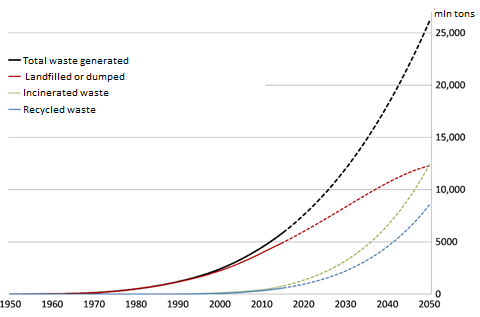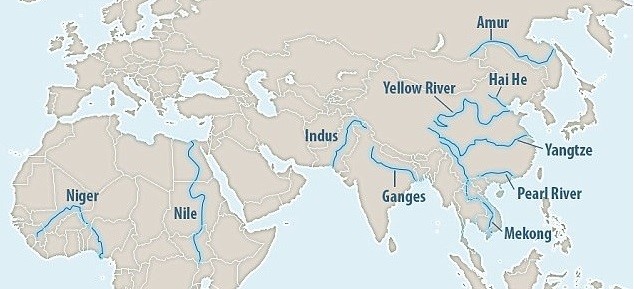People regularly use plastic items that are often dispensable that quickly turn into waste. Judging from the amount of plastic waste generated by an individual, it is difficult to picture the overall scale of negative effects resulting from the improper management of plastic waste. The best way to acknowledge the problem of plastic production and pollution is to analyse the amount of plastic generated worldwide, as well as to study all types of plastic disposed in the landfill. Still, what is the amount of plastic produced by people and what is the amount of plastic waste dumped in the environment?
The production of plastic mostly began in the middle of the 20th century. According to researchers at leading universities in the United States, plastic production amounted to 2 million tons in 1950, while in 2015 its annual production amounted to 380 million tons. According to the same studies, the total amount of plastic produced in the period between 1950 and 2015 was 8.3 billion tons of plastic where 6.3 billion tons of that plastic has already turned into waste. Only 9% of the plastic turned into waste has been recycled, while 12% is incinerated and 79% (4.9 billion tons) is either put in a landfill or dumped.[1]
8.3 billion tons of waste is an amount that is hard to comprehend, but still, what is the mass that we have to deal with? To be able to answer this question and to realize the scale of the problem, we should compare the above amount with the items that are most familiar to us. For instance, 8.3 billion tons of waste is equivalent to 25,000 Empire State Buildings, 822,000 Eiffel Towers, 80 blue whales and 1 billion elephants.
Comparison of the amount of plastic produced prior to 2015 with various buildings and creatures
According to data, half the amount of plastic produced during 1950-2015 has been produced in the past 3 years. Consequently, plastic production has an annually increasing trend and by 2050, around 12 billion tons of plastic is expected to accumulate in landfills and in the environment.

Plastic waste generated, recycled, and deposited in landfills worldwide and predicted data for 2050
Based on the same survey, the amount of total plastic recycled from 1950-2015 is significantly small and produced around 600 (9%) million tons of waste with only 10% of that waste recycled the second time. Notable places distinguished for recycling plastic at a high rate are Europe with 30% and China with 25%, while the US only recycles 9% of its plastic waste. Concerning the percentage of incinerating waste, the 2014 figures in Europe and China indicate 30% and 40% respectively, while the US is 16%. A high recycling rate in China is especially important as it is the largest consumer and producer of plastic in the world.
Currently, pollution caused by plastic is one of the world’s most serious environmental problems. To be able to cope with it, each individual should realize the core of the problem and to actively reduce the amount of waste generated. In addition, it is essential to implement complex measures on a global scale at the policy level, including raising awareness concerning littering and its negative environmental impact, supporting recycling and reducing production and consumption. At this point, less has to be more.
Adverse human impact on Earth and the environment became significant in the 20th century, as mining and mineral processing became the driving force for the growth of the global economy and the transport and energy sectors, among others. The amount of waste generated worldwide grew as the global living standards and economy grew. For example, various studies found that developed states generate more waste than developing states. In particular, the amount of waste generated per capita in OECD member states is twice as large as that in developing states.[2] This could be explained by the fact that a high-income population in developed states purchase more products and services.
Nonetheless, developing countries remain key polluters in terms of household waste as there are no modern waste management systems in developing countries and no recycling, with much of the waste dumped into the environment. A group of scientists have studied the trend of household plastic pollution in oceans and found that 95% of plastic is deposited into the ocean from only 10 rivers: the Nile, Indus, Ganges, Huang He (Yellow River), Yangtze, Niger, Amur, etc.[3] Looking at the basins of the aforementioned rivers (see the graph) we find that they flow into the oceans through the territories of developing countries and the oceans are polluted with plastic coming from those territories.

95% of plastic flows into the ocean via the 10 rivers pictured above flowing through the territories of developing and poorly-developed countries
According to the studies conducted by the American Association for the Advancement of Science, around 8 million tons of waste found its way into the world’s oceans in 2010 alone.
It is interesting to find out about the generation of plastic waste and recycling in Georgia. The most common plastic waste in Georgia is plastic vessels and PET bottles used for product packaging. Their local production and import has significantly increased in the recent years and comprised approximately 30 thousand tons in 2015. Unfortunately, the plastic recycling sector is not developed in Georgia. Only recently has separated waste collection been implemented at local markets through various pilot projects. Almost all collected waste is sent abroad to export which amounted to only 800 tons in 2015, which is around 2-3% of overall plastic waste (PET bottles and plastic vessels).[4]
This overview was prepared in an attempt to define the amount of plastic waste generated by people, and therefore, indicate the enormous effort required of mankind to reduce the adverse impact caused plastic waste. In an upcoming article, we will discuss the specific adverse impacts inflicted on health and the ecosystem by the improper use of plastic and the consequential pollution.
The article is prepared within CENN’s program WMTR II, supported by USAID
The WMTR II program is assisting the Government of Georgia (GoG) to modernize the country’s waste management sector and support sustainable development and inclusive economic growth by the introduction of waste separation and recycling practices. The program is mainstreaming innovative approaches, applying new technologies, and streamlining strong partnerships, to achieve, sustain and extend set objectives and solve development challenges.
The WMTR II is implementing its activities in three regions of Georgia – Kakheti, Shida Kartli, Adjara AR and the city of Tbilisi in the following focus areas:
-Implementation of an Integrated Waste Management System
-Private Sector-Led Recycling
-Illegal Dumping Penalties and Tariff Policy
-Public Outreach
The WMTR II program is implemented by CENN with the support of USAID.
For additional information, visit our web-site: http://environment.cenn.org/
[1] Geyer, Jambeck, Law – “Production, use and fate of all plastic ever made”; Science Advance; 2017.
[2] Urban Development Series – Knowledge papers; waste generation; chapter 3.
[3] http://www.dailymail.co.uk/sciencetech/article-4970214/95-plastic-oceans-comes-just-TEN-rivers.html.
[4] WMTR – Georgian Recycling Market Research, 2015.


